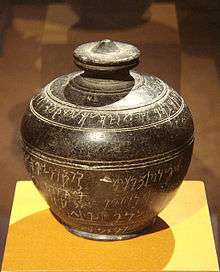Bajaur casket
The Bajaur casket, also called the Indravarma reliquary, year 63,[2] or sometimes referred to as the Avaca inscription,[3] is an ancient reliquary from the area of Bajaur in ancient Gandhara, in the present-day Federally Administered Tribal Areas of Pakistan. It is dated to around 5-6 CE.[4] It proves the involvement of the Scythian kings of the Apraca, in particular King Indravarman, in Buddhism. The casket is made of schist.

The inscription which is written in Kharoshthi, translates into English as:
"In the sixty-third (63) year of the late Great King Aya (Azes), on the sixteenth day of the month Kartia (Karttika); at this auspicious (?) time, Prince Idravarma (Indravarman), son of the King of Apraca, establishes these bodily relics of Lord Sakyamuni in a secure, deep, previously unestablished place; he produces brahma-merit together with his mother Rukhunaka, daughter of Ai (and) wife of the King of Apraca, with (his) maternal uncle Ramaka, with (his) maternal uncle's wife Dasaka, with (his) sisters and wife --Vasavadatta, Mahaveda, and Nika, and (his) wife Utara. And (this is done) in honor of (his) father Visnuvarma. The King of Avaca (Apraca) 's brother, the Commander Vaga is honored, and Vijayamitra, (former) King of Avaca. (His) mother's sister, Bhagidatta is honored. And these bodily relics having been brought in procession from the Muryaka cave stupa, were established in a secure(?), safe, deep(?) depository, (in) the year twenty-five."
The inscription was highly useful in clarifying the little-known Apraca dynasty.[5]
Notes
- Metropolitan Museum of Art notice
- Nouvelles inscriptions Saka : ère d'Eucratide, ère d'Azès, ère Vikrama, ère de Kaniska, Gérard Fussman, Bulletin de l'École française d'Extrême-Orient, Year 1980 Volume 67 Number 1 pp. 1-44
- Metropolitan Museum of Art, museum notice.
References
- Baums, Stefan. 2012. “Catalog and Revised Texts and Translations of Gandharan Reliquary Inscriptions.” In: David Jongeward, Elizabeth Errington, Richard Salomon and Stefan Baums, Gandharan Buddhist Reliquaries, pp. 207–208, Seattle: Early Buddhist Manuscripts Project (Gandharan Studies, Volume 1).
- Baums, Stefan, and Andrew Glass. 2002– . Catalog of Gāndhārī Texts, no. CKI 242
- Richard Salomon (January–March 1982). "The "Avaca" Inscription and the Origin of the Vikrama Era". Journal of the American Oriental Society. Journal of the American Oriental Society. 102 (1): 59–68. doi:10.2307/601111. JSTOR 601111.
